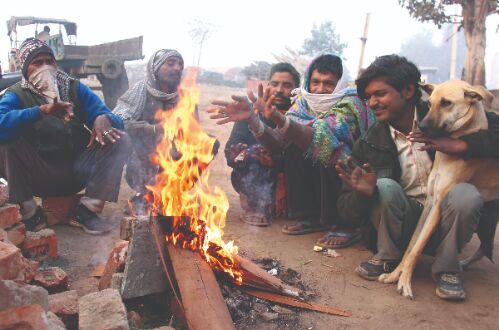Bitter cold persists in north India, light snowfall likely in Kashmir

New Delhi: Bitter cold conditions persisted in most parts of north India on Thursday as the minimum temperatures hovered well below the normal limits at several places in Punjab, Haryana and Rajasthan.
There was slight improvement in cold conditions in Kashmir as the minimum temperature rose across the valley, even as the Meteorological office forecast the possibility of light snowfall over two days from Saturday. In Haryana and Punjab, the minimum temperatures hovered well below the normal limits.
Adampur in Punjab reeled under intense chill recording a low of 1.6 degrees Celsius, while biting cold prevailed in Ludhiana too at 2.1 degrees Celsius.
In Haryana, Ambala, Karnal, Narnaul, Rohtak, Bhiwani and Sirsa also registered below normal minimums at 5.7, 2.9, 4.6, 4.6, 5.2 and 6.3 degrees Celsius.
Chandigarh, the common capital of the two states, recorded a low of 4.7 degrees Celsius. Himachal Pradesh's Keylong, Kalpa and Mandi shivered at sub-zero temperature.
The tribal district Lahaul-Spiti's administrative centre Keylong remained the coldest place in the state at minus 8.4 degrees Celsius, Met centre Shimla director Manmohan Singh said. Kalpa in Kinnaur district and Mandi recorded a low of minus 2.2 and minus 1 degrees Celsius, he added.
Manali, Dalhousie and Kufri recorded a low of zero, 4.3 and 4.5 degrees Celsius respectively.
The minimum temperature in Shimla was recorded at 4.1 degrees Celsius, he added. The Met centre has forecast rain and snowfall in isolated places of the state on December 27 and 28.
In Jammu and Kashmir, the night temperature marked an improvement but continued to settle below the freezing point, the Met officials said.
The weather has remained dry and cold across Kashmir since the snowfall on December 12, with the night temperature staying several degrees below the freezing point, they said.
The officials said Srinagar the summer capital of Jammu and Kashmir recorded a low of minus 3.8 degrees Celsius up from the previous night's minus 5 degrees Celsius. Gulmarg was the coldest recorded place in the valley. Kashmir is currently under the grip of 'Chillai-Kalan' — the 40-day harshest winter period when the chances of snowfall are most frequent and maximum.
'Chillai-Kalan', which began on December 21, is considered the harshest winter period in Kashmir as a cold wave grips the region and the temperature drops considerably leading to the freezing of water bodies including the famous Dal Lake here as well as the water supply lines in several parts of the valley. While 'Chillai-Kalan' will end on January 31, the cold wave continues even after that in Kashmir with a 20-day-long 'Chillai-Khurd' (small cold) and a 10-day-long 'Chillai-Bachha' (baby cold).
The Met office has said the weather is likely to remain mainly dry till December 25, but there is a possibility of light in the valley for two days from Saturday. There is no forecast of any major snowfall activity till the end of this month, it added.
In Uttar Pradesh, a blanket of very dense fog enveloped isolated places.
According to the weather office in Lucknow, there was no major change in the night temperatures across the divisions of the state.
The night temperature was appreciably below normal in Gorakhpur, Bareilly and Moradabad divisions, below normal in Ayodhya, Lucknow, Prayagraj and Kanpur divisions and normal in the rest, it said. The lowest minimum temperature in the state was recorded in Muzaffarnagar at 2.5 degrees Celsius, while Jhansi, with 26.1 degrees Celsius, recorded the highest temperature.
The Met forecast said the weather would most likely remain dry in the state and dense fog was very likely at isolated places on Friday morning.
Most parts of Rajasthan too reeled under intense cold conditionsand Churu was the coldest place in the state with a minimum temperature of 4.8 degrees Celsius followed by Pilani where the night temperature was 4.9 degrees Celsius.



